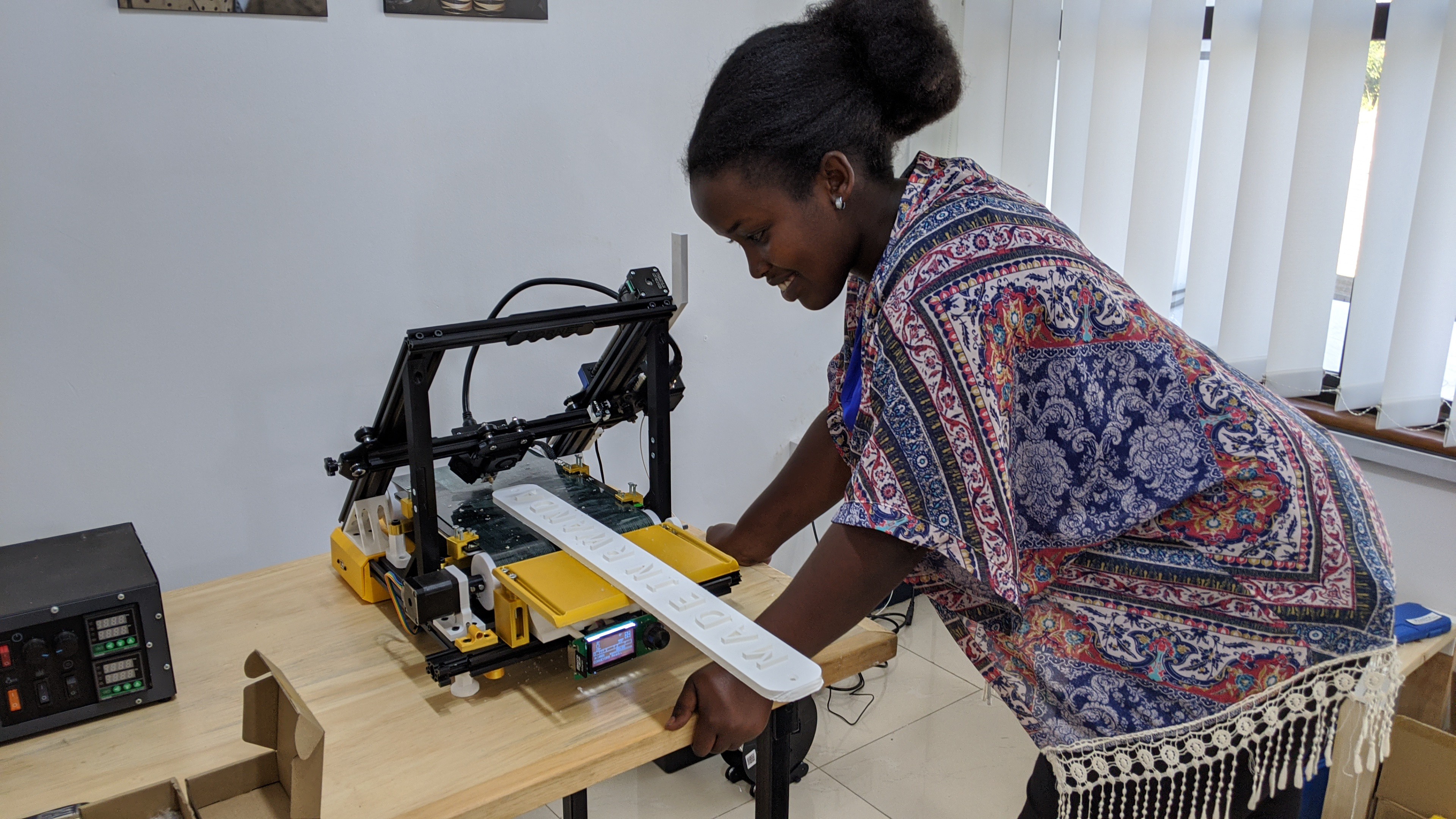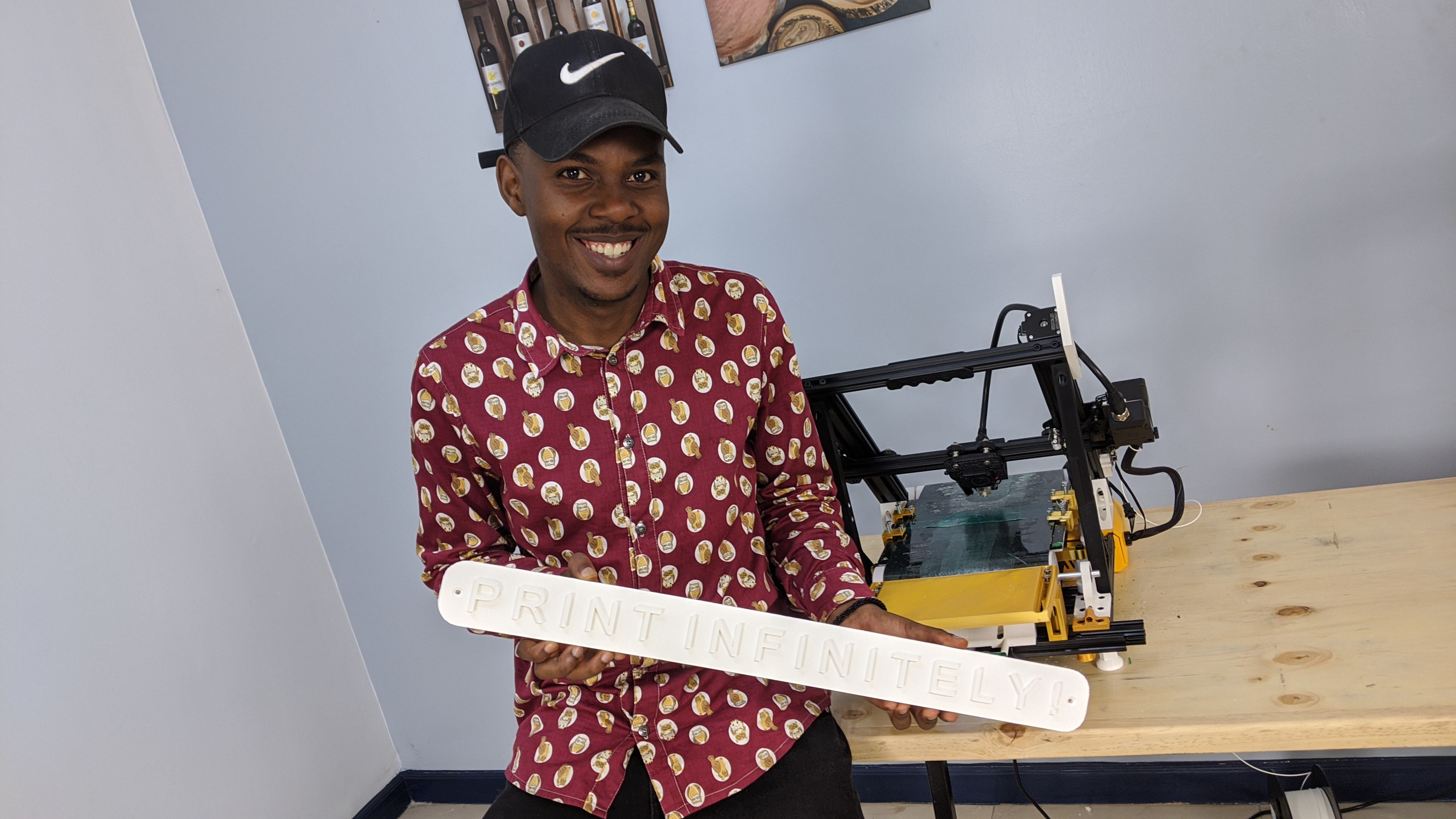**BEFORE ANYTHING ELSE, CHECK THIS OUT. IT WILL ANSWER ALL QUESTIONS.**👇👇
[Figure 1: Full Explanation Video]
Intro
Conveyor belt 3D printers are arguably the most exciting development in 3D printing since RepRap. With its unique design, a conveyor belt 3D printer has two features which no other desktop 3D printer can offer: automatic part ejection and infinitely long printing. Resultantly, a conveyor belt 3D printer can both mass produce parts and print extremely large parts. If it works…
Over the past half decade, a number of desktop conveyor belt 3D printers have been released to the public. Unfortunately, these machines are buggy and finicky; their print quality does not meet our expectations of a 3D printer in 2022. Current conveyor belt printers are reminiscent of hobby 3D printers from 2007-2009: low quality, unreliable, prototype adjacent, but also lots of fun! The caveats and details of conveyor belt 3D printers still need to be ironed out. I believe that there is a missing ingredient that will rapidly move this design forwards: community. In its early stages, amateur 3D printer designs made rapid progress due to a large, committed, opensource community that was working together to make low cost 3D printers viable. Conveyor belt 3D printers need the same open source catalyst.
I have built many, many, many, many, many conveyor belt 3D printers. From the knowledge gained through these successes (and failures), I have designed a new conveyor belt 3D printer that is extremely simple for people to build. The 3D printer is completely free and opensource with the CAD and firmware available in this document. I have also provided detailed build instructions to make it straight forwards for others to replicate (and hopefully improve) the 3D printer. Due to the opensource nature of this project, I have aptly named this 3D printer design OpenBelt - The Opensource Conveyor Belt 3D Printer.
Demos
[Figure 2: Printing Sword Demo]
[Figure 3: Printing Skateboard Demo]
[Figure 4: Printing Funny Thing Demo]
[Figure 5: Printing Cricket Bat Demo]
Design Choices
My goal is that as many people as possible are able to replicate this 3D printer. Therefore, I tried to make the design accessible and easy to follow for people from all technical background. In pursuit of this goal, I made the following design choices while developing this project.
- All components for this project can be 3D printed
In my previous conveyor belt 3D printer designs, I used a lathe and mill to machine some of the components. I am assuming most people attempting this project do not have access to such expensive machines. So I specifically designed all of the fixtures, jigs, and other components to be 3D printable. I hope this makes it easier for others to fabricate these components. - Simple Design >>> Perfect Design
I chose to make this conveyor belt 3D printer as simple as possible. There are many extra features that I would love to add to this machine. But I chose to only include the bare essentials for this tutorial. - Starting with a 3D Printer
In this tutorial, we start with an existing 3D printer and convert it into a conveyor belt 3D printer. If I were to instead build the 3D printer from scratch, I would have to include a lot of additional details that are irrelevant to the key conveyor belt aspect. There are already many tutorials online that document building a 3D printer from raw materials. I see no point reinventing the wheel. If you are looking for a good resource on building 3D printers from scratch, I recommend Dr. D Flo’s YouTube Channel!
Future Skills Center (FSC) Support
This project was generously supported by the Future Skills Center (FSC) federal program, via McMaster University. In exchange for academic support, an OpenBelt 3D printer is currently active at McMaster University's Learning Factory Industry 4.0 Lab. Students are welcome to use the 3D printer for any academic/hobby purposes.
FSC is a pan-Canadian organization passionate about creating a future in which everyone has life-long access to high-quality career advice and learning opportunities. You can learn more about FSC at the program website: https://fsc-ccf.ca/who-we-are/.
Project History
The first time I used a 3D printer was in my freshman year of high school. After a few hours of working with the machine, I realized that a conveyor belt would be an excellent way to automate 3D printers and allow them to print a continuous stream of parts. After doing some online research, I came across the defunct Makerbot Replicator project. Seeing that a large company failed to successfully build such a conveyor belt for a 3D printer, I assumed that such a device was not technically feasible.
In December 2017, I saw the Kickstarter video for the Blackbelt 3D Printer. I was extremely impressed by the 3D printer; both its capacity for mass production and infinite printing capabilities. Since the machine cost several thousands dollars it was well out of my price range. Instead, I sought to build my own low cost conveyor belt 3D printer. I won several project grant competitions at my university and I was able to bootstrap my project. I tested my first conveyor belt 3D printer on January 30th 2018. I proceeded to build several more iterations of my conveyor belt 3D printer. Below is a demo of my most popular iteration which I also entered in the 2018 Hackaday Prize.
[Figure 6: Mk IV Demo Video]
While developing my conveyor belt 3D printer, I relied on documentation from many other people online working on similar projects. For example, I routinely watched the YouTube channels of Zechy Coyte-King and Brook Drumm for advice / aha moments. Now it’s my turn to create documentation that will facilitate, assist, and inspire other people’s projects. Conveyor belt 3D printers have been around for half a decade. And in that time, the design of conveyor belt 3D printers has remained relatively stagnant. Compare the progress of FDM 3D printers between 2009-2014 and conveyor belt 3D printers between 2017-2022. The difference is staggeringly depressing. I believe the reason conveyor belt 3D printers have not taken off is because they do not have a community that supports them. Hobby 3D printers did not explode in popularity because of a single individual or company, but because there was a community working together to develop the machines. Conveyor belt 3D printers need a similar community to develop and improve the machine design. So that a large corporation can steal and profit off it :)
Components to Print
Below is the parts lists for the all of the essential components to print. I have also included the CAD files for a few extra unnecessary files in the repo.
[Table 1: Components to Print]
| Component | Quantity |
| ANGLE_BLOCK | 2 |
| BELT_FLATTENER | 4 |
| BOTTOM_BRACE | 2 |
| BOTTOM_FOOT | 2 |
| BOTTOM_LEG | 2 |
| BRACE | 2 |
| CORNER_BRACE | 2 |
| CORNER_BRACE_LONG | 2 |
| COUPLER | 1 |
| DRUM | 2 |
| EXTENSION_BOTTOM | 2 |
| EXTENSION_TOP | 2 |
| EXTRUDER_BRACE | 1 |
| FRONT_BEARING_BLOCK | 1 |
| HEATBED_STRUT | 2 |
| MOTOR_BLOCK | 1 |
| REARING_BEARING_BLOCK | 2 |
| SHEAR | 1 |
| STANDOFF_MOUNT | 4 |
| TENSIONING_BLOCK | 2 |
Move to Rwanda
[Figure 7: Bringing Conveyor Belt 3D Printing to Rwanda]

[Figure 8: Made in Rwanda Sign]

[Figure: Print Infinitely Sign]
In the middle of writing the documentation for this project, I moved from Toronto, Canada to Kigali, Rwanda. I made the move to install one of my conveyor belt 3d printers at E-Commerce Rwanda: a local makerspace in Kigali which is funded by the Rwandese and German governments. Local Rwandese entrepreneurs, students, and youth will get to use the 3D printer for their technical projects. And I think that is friggin awesome! I hope to see more conveyor belt 3D printers pop up around the world in the future.
Credit
I have no intention to sell this 3D printer. This is purely an open source project that I hope will inspire other more innovative designs. Currently my life goal is to be a famous engineering YouTuber ala the next StuffMadeHere. In order to achieve this goal, I need clout and a lot of it. So if you don’t mind please subscribe to my YouTube channel. I promise, the illest engineering projects of 2022 will be on there. To my knowledge, I have created the most viral videos on conveyor belt 3D printers. But I do not receive much credit in the media when conveyor belt 3D printers are discussed. I understand this lack of recognition is part of creating open source projects, but I feel like I need to promote myself more for my YouTube channel to be successful. So if you can help me out, I would appreciate it!
Support
This project was aided by Artillery3D, Powerbelt, and Future Skills Canada. I have linked these entities below for your reference.
 Swaleh Owais
Swaleh Owais